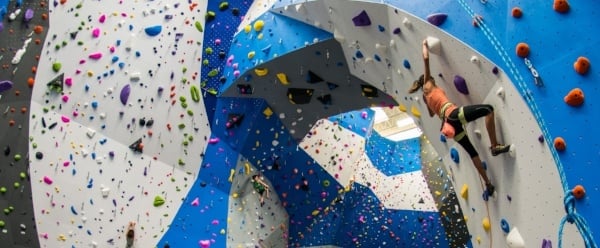
So you have received your lead certification and entered the thrilling world of sport climbing? Well, that is just step one! Even when you have started to lead climb, there are still plenty of techniques to learn and precautions to take.
BE AWARE OF YOUR OWN STRENGTH
Top roping is surprisingly different than lead climbing. While you may be climbing a 5.11a on top rope, you might not be able to do so when leading! On top rope, the rope itself is assisting you up the wall, even if your belayer is being generous with their slack. On lead, there is nothing pulling you up, and you also must account for the time it takes to lock off and clip every quickdraw. It becomes harder than climbing with a top rope.
The most common mistake we see is those who overestimate their strength when transitioning from top rope to lead. If you jump on your top rope project on lead, it is going to be a very different experience, and you will probably fall a lot sooner than you originally expected.
The best way to figure out how hard you can lead climb is to start over. Take a nice and long warm up session to go back through the grades you can easily do on top rope. Try to climb routes you are familiar with and notice the difference in difficulty now that you are on lead. Use this information to help yourself set new limits.
Check out these cool training regiments from Climbing Magazine to train endurance and lock off strength.
DON'T BE AFRAID TO TAKE FALLS
A lot of climbers prevent themselves from completing a climb simply because they are afraid to fall. Falling can be quite frightening, but is also necessary to create improvement. If you climb and decide to take rather than fall, then you are not pushing your body hard enough to make physical gains in strength and endurance. When you push yourself to the point where you literally cannot hang on any longer, that is when you begin to see growth. However, it is important to fall properly!
The most common mistake we see when falling, is what is often referred to as “the death grip”. Rather than using their arms and legs to brace themselves, some people grab onto their rope and end up slamming against the wall. Practice taking falls with your arms and legs stretched out, ready to absorb any impact shock.
There are many ways to reduce what is called “lead head”, but the best way is to just take more falls. Try playing “the fall game” in which the belayer can call out “fall, fall, fall!” and the climber must immediately let go of the wall. Earth Treks also offers a clinic called “Whipper Therapy” in which you can learn proper technique in a supervised environment.
COMMUNICATE
The more you lead climb, especially with a single partner, the more you tend to become complacent about simple things. Communication becomes even more important the more you become comfortable, because that is when mistakes happen. Remember to always double check each other, call out mistakes, and update each other on the wall.
The most common mistake we see when partners get complacent is when the belayer loses sight of their climber under an overhang and pulls them off the wall. This could be avoided if the climber yells out “clipping!” when they would like to pull up some rope, but also if the belayer lets the climber know they can no longer see them and needs this warning.
Look over this list of useful commands by REI to see what works best for you!
DON'T FORGET TO FLAKE OUT YOUR ROPE
Flaking out your rope before every climb is an important step some experienced lead climbers forget to do. Flaking out ensures two things: that the rope has no knots in it, and that the rope’s integrity is up to par.
The most common mistake we see is when partners forget to flake out and the belayer discovers a huge knot when the climber is already half way up the wall. The knot will prevent the belayer from feeding any more slack, and the climber will essentially be stuck and forced to come back down.
Find a Movement gym near you.

